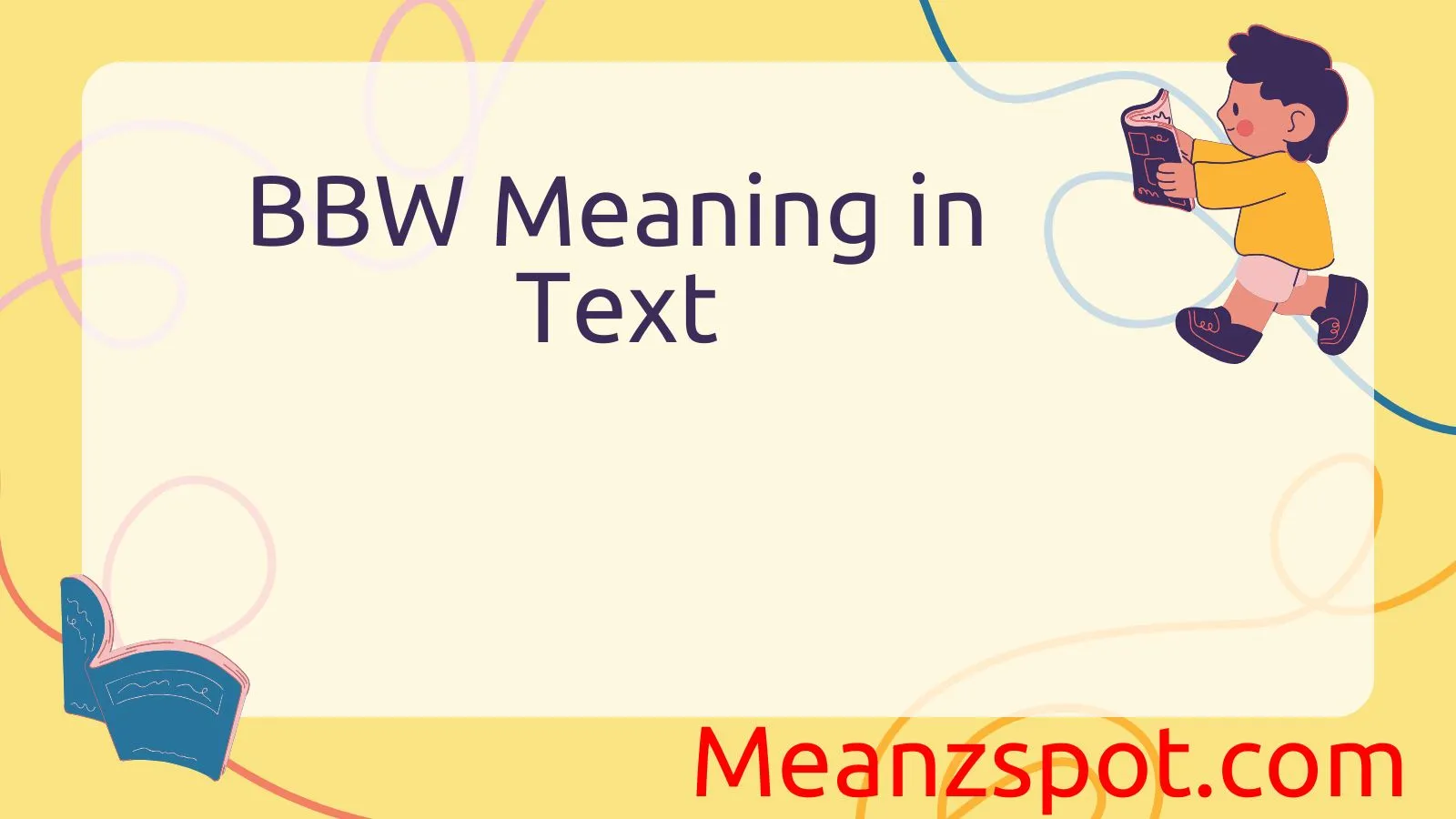In the world of trending texting slang, staying updated is more important than ever. One acronym you’ve probably seen floating around is BBW—but what does it really mean? Whether it shows up in a DM, dating profile, meme, or even in pop culture, BBW carries more than just a surface-level definition. It’s often used to describe a body type, but there’s a rich cultural background and evolving context behind it. Understanding BBW isn’t just about knowing what the letters stand for—it’s about grasping what they represent in modern conversations, especially around body positivity, beauty standards, and identity.
This article breaks down the meaning of BBW in text, explores how it’s used across platforms like TikTok, Instagram, and dating apps, and clears up the common misconceptions. Whether you’re curious, confused, or just want to stay in the know, this guide will help you make sense of it all.
Definitions & Meaning
At its core, BBW stands for “Big Beautiful Woman.” It is used to describe women who are plus-sized or have fuller figures, celebrating body confidence and self-love. Unlike derogatory labels that have been historically assigned to larger bodies, BBW carries a positive connotation, emphasizing beauty, empowerment, and desirability. In text conversations, users often employ BBW as a compliment—acknowledging that beauty can come in diverse shapes and sizes. For example:
- “I met a BBW influencer who’s advocating for body positivity.”
- “She’s such a BBW icon—so confident and inspiring!”
In some contexts, BBW can also denote a specific genre of dating preferences, where individuals express attraction to plus-sized partners. Dating sites and apps may have categories or tags like “BBW friendly” or “BBW sought,” helping members connect based on shared preferences. It’s worth noting that while BBW is generally affirmative, understanding the audience is crucial: using it in a professional or sensitive setting without awareness can lead to misunderstandings.
Origins & History
The term BBW emerged in the late 20th century alongside the body positivity movement’s early stirrings. In the 1990s, plus-size fashion magazines and online forums began to popularize BBW as a way to counter mainstream beauty standards that idolized thinness. Communities formed around the idea that all body types deserved representation, and BBW became a rallying cry for inclusion.
One of the earliest appearances of BBW can be traced back to internet bulletin boards and early chatrooms, where users exchanged fashion tips, relationship advice, and support. As the internet matured, BBW found its way into mainstream websites and social media platforms, appearing in blog posts celebrating curvier figures. Over time, fitness influencers, models, and celebrities embraced BBW, further legitimizing and amplifying its positive message.
Today, BBW is not only a descriptor but also a cultural phenomenon. It has transcended niche communities to influence fashion lines, inclusive marketing campaigns, and media representation. Celebrities and public figures who identify as BBW often share their journeys toward self-acceptance, reinforcing that beauty is multifaceted. The evolution of BBW underscores a broader shift in societal attitudes toward body diversity and acceptance.
Usage in Different Contexts
Social Media
On platforms like Instagram, Twitter, and TikTok, BBW is used both as a hashtag (#BBW) and in captions to highlight body-positive content. Influencers share images and stories that challenge beauty norms, and followers engage with supportive comments and shares. For example:
“Feeling gorgeous in my new dress! #BBW #BodyPositivity”
Such posts foster a sense of community where users uplift one another and celebrate different body types.
Dating & Relationships
In online dating profiles, BBW often appears as a tag that specifies either the user’s body type or their preference. Tags like “BBW seeking BBW” or “BBW friendly” allow better matching for those who want partners within the plus-size community. This direct communication helps set clear expectations and fosters connections based on mutual attraction and respect.
Professional & Media
While BBW primarily exists in informal contexts, it occasionally surfaces in professional conversations surrounding marketing, fashion, and health. Brands may launch BBW-inclusive campaigns, featuring models who advocate for size diversity. Media outlets reference BBW when discussing representation in film, television, and advertising. In these cases, a nuanced understanding of BBW helps professionals design more inclusive initiatives.
Pop Culture
Music videos, movies, and television shows have increasingly included BBW characters as love interests and protagonists. Storylines focusing on body positivity have made BBW a recognized term beyond internet culture. For example, a film might feature a BBW lead who navigates self-confidence and societal pressures, resonating with audiences worldwide.
Common Misunderstandings & Clarifications
Despite its positive intent, BBW can sometimes be misinterpreted or cause discomfort:
- Derogatory Misuse: When used by individuals with body-shaming attitudes, BBW can feel objectifying rather than empowering. Tone and context matter.
- Assumption of Fetishization: Some assume BBW references only a sexual preference, overlooking its broader cultural meaning. Not every use of BBW implies fetishism.
- Exclusion of Other Identities: Focusing solely on BBW without acknowledging “Big Handsome Men” (BHM) or “Big Beautiful People” (BBP) can seem exclusionary. Using inclusive terms when appropriate fosters better dialogue.
To navigate these pitfalls, it’s best to use BBW respectfully, ensuring consent and awareness of the audience’s comfort level. Clarify intent if there’s potential for misunderstanding—for instance, noting whether you admire a person’s confidence or indicating a dating preference.
Alternatives & Synonyms
While BBW is widely recognized, alternatives and synonyms can provide broader inclusivity or suit different tones:
- Plus-Size: Often used in fashion and retail, e.g., “plus-size models”.
- Full-Figured: Emphasizes body shape without specific size connotations.
- Curvy: Highlights curves, suitable for various contexts.
- BBP (Big Beautiful Person): Gender-neutral term for anyone.
- BHM (Big Handsome Man): Specifically for men.
Choosing the right term depends on the context and the individuals involved. Always prioritize respectful language and, when in doubt, ask people how they identify.
Frequently Asked Questions (FAQ)
- Q: Is BBW derogatory?
A: No, BBW is generally positive, celebrating body confidence. However, tone and intent matter; avoid using it to objectify or shame. - Q: Can I use BBW in a professional setting?
A: Use caution. BBW is informal, so opt for terms like “plus-size” or “full-figured” in professional contexts. - Q: What’s the difference between BBW and curvy?
A: “Curvy” focuses on body shape and curves, regardless of size, while BBW specifically refers to plus-sized women. - Q: Are there equivalents for men?
A: Yes, BHM (Big Handsome Man) and BBP (Big Beautiful Person) are common equivalents. - Q: How did BBW originate?
A: It emerged in the 1990s within body-positive communities online, used to challenge narrow beauty standards. - Q: Is BBW the same as a fetish?
A: Not inherently. While some use BBW in fetish contexts, its core meaning is about celebrating beauty, not solely sexual attraction. - Q: Can I tag #BBW on my post?
A: Yes, if it aligns with your message celebrating plus-size beauty or body positivity.
Conclusion
BBW has evolved from a niche internet acronym to a widely recognized term that champions body positivity and inclusivity. Understanding its definitions, history, and varied applications empowers us to communicate more effectively and sensitively. While BBW primarily highlights plus-sized women, its broader message encourages acceptance of diverse body types.
By being mindful of context and audience, and by using respectful language, we can ensure that BBW remains a positive, empowering expression. Whether you encounter BBW on social media, in dating profiles, or in pop culture, you now have the clarity to appreciate its meaning and embrace its spirit of self-love and representation.



